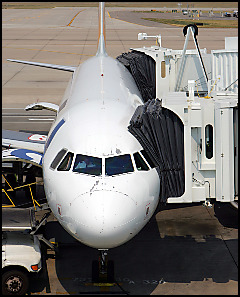Jumpseatnews.com - United Airlines flight attendant resources
Future of United's high-tech passenger bridges uncertain
Airline awaiting results of probe into collapse of state-of-art device
By Chris Walsh, Rocky Mountain News
June 26, 2007
 The future of United Airlines' automated jet bridges for loading and unloading passengers remains in limbo as the carrier completes its investigation into how one collapsed in Denver nearly three months ago.
The future of United Airlines' automated jet bridges for loading and unloading passengers remains in limbo as the carrier completes its investigation into how one collapsed in Denver nearly three months ago.
United has brought in a third-party company to conduct "a complete investigation" on the portion of the high-tech bridge that malfunctioned.
The carrier recently relocated that portion of the bridge from the gate area at Denver International Airport to an off-site area, as part of the investigation.
The move comes even as the company that makes the state-of-the-art bridges - which allow passengers to board and deplane from both the front and back doors of a plane - has nearly wrapped up its own investigation.
United has not used the rear arm of any of the new bridges since the incident occurred. "Right now, we're making sure we determine the root cause of the incident with the jet bridge," said United spokeswoman Megan McCarthy. "This is just one step in the investigation."
Canada-based Dewbridge Airport Systems, which built the bridges for United, is not yet ready to release the findings of its investigation. But an official said the company is confident about the technology's future.
"Although we've done our own investigation, United is doing its own independent investigation as well," said Neil Hutton, vice president of Dewbridge. "It wouldn't be appropriate to comment right now."
The bridge that collapsed is one of five United installed at DIA last year in a move to speed up the boarding and deplaning of passengers.
The bridges have sensors that detect a plane's position and then automatically connect to the front and back doors, with the rear arm of the bridge extending over the plane's wing.
In late March, the back arm of one of the bridges buckled and crashed into the wing of a plane as it was preparing to deplane passengers. No one was injured.
The airplane involved - a Boeing 757 - was damaged but is now back in service.
United continued using the main portion of the bridge that connects to the front of the plane, but stopped using the back arm, which essentially had fallen off.
It also has stopped using the rear arms of the other four automated bridges as it investigates the incident. United hoped the bridges would help trim its "turn" time - how long it takes to unload and then reboard a plane - by 10 minutes. That, in turn, would allow the company to fly its planes longer each day, helping lower costs.
The carrier once planned to add more of the bridges in Denver and across its system if the experiment at DIA proved successful. The airline declined to comment on those plans now, saying it will depend on the results of the investigation.
Carriers have experimented with dual-end bridges for several decades, but they haven't become commonplace amid concerns over the stability of the section that extends over the wing, said Henry Harteveldt, a vice president at Forrester Research.
He said United will have to determine that there's "better than a 99.999 percent chance that the bridge will not collapse" if it's going to use them again.
"If United and the manufacturer can't come to terms on the reliability issue, this is dead," Harteveldt said of the automated bridges. "No airline, no airport is going to install it."
< Return to Latest News
Quick Find
- Unimatic Access
- CCS | Bid Packages
- Flying Together | Webmail
- EmployeeRES | Fare Calculator
- Forms | Paychecks | Benefits | Discounts
- ANP | Leave of Absence | eLearning | CQ
- PED Supplement
- Briefing Sheets | Purser | Tools | FAOM
- Uniforms: Info | Order | Tailors
- Phone Directory | Medical | W2 Form
Travel and Safety
- EmployeeRES | Fare Calculator
- Edit Your Pass Riders | Get Reports
- Jumpseat Travel
- Visas/Passports | Policies | Companions
- Reciprocal Cabin Agreements | ZED
- Known Crewmember | IOR